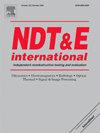U-NET autoencoder for amplitude recovery on binarized Full Matrix Captures
IF 4.5
2区 材料科学
Q1 MATERIALS SCIENCE, CHARACTERIZATION & TESTING
引用次数: 0
Abstract
Full Matrix Capture (FMC) and the Total Focusing Method (TFM) are instrumental techniques in ultrasonic nondestructive testing (NDT) in industries such as aerospace, oil and gas, and manufacturing, and allow efficient defect detection by capturing all possible transmitter–receiver pairs and generating highly resolved images on a predefined pixel grid. The use of dense linear or matrix probes presents significant challenges in data storage and transfer but also in the complexity of the acquisition system’s electronics. In this context, binary acquisition steps in as an attractive alternative for simplifying acquisition equipment and reducing data size. However, binary formats carry the drawback of amplitude information loss. To address this, the present study explores the application of a U-NET autoencoder neural network to reconstruct amplitude data from binarized FMC signals. The autoencoder’s U-NET architecture is particularly suited for this task due to its effectiveness with limited datasets, a common issue in NDT. Finite element simulations were used to generate training and validation datasets. Experimental tests were then conducted on steel samples containing various defects, such as Electrical Discharge Machining (EDM) cracks, side-drilled holes (SDH), and a realistic fatigue crack in a steel bar. The reconstructed FMC data were evaluated using TFM images and Structural Similarity Index Measure (SSIM), showing that the neural network accurately reconstructed FMCs. Notwithstanding the presence of minor amplitude errors, the spatial positioning of defects remained precise, demonstrating the method’s viability for practical NDT applications.
用于二值化全矩阵捕获的幅度恢复的U-NET自编码器
全矩阵捕获(FMC)和全聚焦法(TFM)是超声无损检测(NDT)的仪器技术,应用于航空航天、石油和天然气以及制造业等行业,通过捕获所有可能的收发器对并在预定义的像素网格上生成高分辨率图像,可以实现有效的缺陷检测。密集线性或矩阵探头的使用在数据存储和传输以及采集系统电子设备的复杂性方面提出了重大挑战。在这种情况下,二进制采集作为简化采集设备和减少数据大小的一种有吸引力的替代方法而出现。然而,二进制格式有幅度信息丢失的缺点。为了解决这个问题,本研究探索了U-NET自编码器神经网络的应用,以重建二值化FMC信号的幅度数据。自动编码器的U-NET架构特别适合这项任务,因为它在有限的数据集上有效,这是无损检测中的一个常见问题。有限元模拟用于生成训练和验证数据集。然后对含有各种缺陷的钢样品进行了实验测试,例如电火花加工(EDM)裂纹、侧钻孔(SDH)和钢筋中的实际疲劳裂纹。利用TFM图像和结构相似指数(SSIM)对重建的FMC数据进行评价,结果表明神经网络能够准确地重建FMC。尽管存在较小的幅度误差,但缺陷的空间定位仍然精确,证明了该方法在实际无损检测应用中的可行性。
本文章由计算机程序翻译,如有差异,请以英文原文为准。
求助全文
约1分钟内获得全文
求助全文
来源期刊

Ndt & E International
工程技术-材料科学:表征与测试
CiteScore
7.20
自引率
9.50%
发文量
121
审稿时长
55 days
期刊介绍:
NDT&E international publishes peer-reviewed results of original research and development in all categories of the fields of nondestructive testing and evaluation including ultrasonics, electromagnetics, radiography, optical and thermal methods. In addition to traditional NDE topics, the emerging technology area of inspection of civil structures and materials is also emphasized. The journal publishes original papers on research and development of new inspection techniques and methods, as well as on novel and innovative applications of established methods. Papers on NDE sensors and their applications both for inspection and process control, as well as papers describing novel NDE systems for structural health monitoring and their performance in industrial settings are also considered. Other regular features include international news, new equipment and a calendar of forthcoming worldwide meetings. This journal is listed in Current Contents.
 求助内容:
求助内容: 应助结果提醒方式:
应助结果提醒方式:


